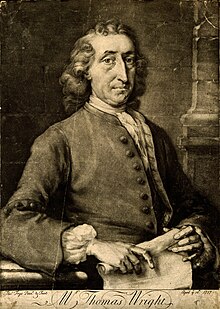Thomas Wright (philosopher)
Thomas Wright (born September 22, 1711 in Byers Green , † February 22, 1786 ) was an English philosopher , astronomer , mathematician , instrument maker, architect and horticultural architect.
Act
His most important work is An original theory or new hypothesis of the universe (1750). In it he represented the idea (already expressed by Giordano Bruno ) that the sun does not represent the center of the universe as in the Copernican view of the world , but is in reality a fixed star among many. Wright rejected the assumption of a homogeneous star distribution and identified the Milky Way as a single star disk with the sun in its plane. He also viewed the nebulae observed by astronomers as other galaxies .
Thomas Wright, along with the American astronomers William H. Wright (1871–1959) and Frederick E. Wright (1877–1953), is one of the namesake of the Wright crater .
Fonts
- An original theory or new hypothesis of the universe. 1750.
literature
- Vera Gushee: Thomas Wright of Durham, Astronomer. In: Isis. Volume 33, No. 2, June 1941, pp. 197-218.
- Anna Holterhoff: Thomas Wright of Durham: An Original Theory of the Universe. In: Anna Holterhoff: Science versus Religion? On the relationship between theology and cosmology in the 18th century. Max Planck Institute for the History of Science, Berlin 2009, pp. 38–50 ( PDF ).
Individual evidence
- ↑ Thomas Wright (1711-86) of Byers Green, Co. Durham, the astronomer, architect and landscape gardener. Durham University, accessed April 10, 2014 .
- ↑ lunar craters Wright on astrolink.de
Web links
| personal data | |
|---|---|
| SURNAME | Wright, Thomas |
| ALTERNATIVE NAMES | Wright of Durham, Thomas |
| BRIEF DESCRIPTION | English philosopher, astronomer, mathematician, architect |
| DATE OF BIRTH | September 22, 1711 |
| PLACE OF BIRTH | Byers Green |
| DATE OF DEATH | February 22, 1786 |

